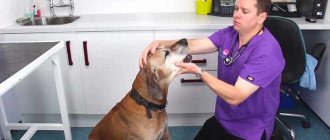Pet diseases are always difficult to diagnose. If a dog's paw is swollen, it could be a mechanical injury, a bone fracture, or a disease of the internal organs.
After an injection and other medical procedures, swelling may also appear. This symptom cannot be ignored; it is important to identify the factors that provoke swelling.
The main causes of edema in dogs
First you need to decide what exactly is meant by “peripheral edema” of the body.
- Firstly, swelling itself is not a disease. It is only a consequence of other pathologies that contribute to an increase in the porosity of blood vessels and the release of the liquid fraction of blood into the tissue.
- Secondly, peripheral edema can be local (swelling of the paws, for example), or generalized (over the entire area of the body). Naturally, veterinarians consider the first case to be the easiest.
The severity of edema varies and is also classified:
- Pasty. The swelling is barely noticeable, often only noticeable upon palpation.
- Pronounced, easily visible swelling.
- Anasarka. The swelling is very strong, sharp, the affected tissues are literally swollen.
The causes of edema in dogs, which are not observed in pure form very often in veterinary practice:
- Swelling is a consequence of the presence of inflammatory mediators in the blood. They increase the porosity of the vascular wall, due to which the liquid fraction of the blood begins to leak into the tissue.
- Peripheral edema is a common consequence of poor nutrition. More precisely, a lack of proteins in food (impaired oncotic pressure). For example, this happens when a dog is constantly fed low-quality economy-class food. True, this rarely happens. But with cachexia (i.e. extreme exhaustion), the dog may look “obese” due to swelling of the whole body.
- In rare cases, peripheral edema develops in dogs suffering from chronic hypertension (it also happens in animals).
- Occurs in very old dogs due to age-related problems with protein metabolism. All this leads to the same problems with oncotic pressure.
- In some cases, the periphery swells after severe physical activity and excessive drinking immediately after it.
- Very rarely, swelling is a consequence of pinched nerves.
Good to know
- Dog breathing problems?
- Why does my dog often vomit yellow or white foam?
- Why doesn't the dog eat anything? The dog doesn't eat?
- Why does a dog scratch its ears and shake its head?
- The reason why your dog constantly whines?
- Why is my dog breathing heavily and frequently?
- Why does a dog eat cat feces?
- Why does a dog drink a lot of water?
- Eye discharge in dogs
- Why does a young dog have bad breath?
- Why does a dog lose hair?
- Why does my dog have diarrhea? Dog diarrhea
- How to treat bartonellosis in dogs
- Bordetelosis and Bordetella in dogs
- How to treat adenovirus in dogs?
- Why is the dog lethargic?
The main diseases causing the formation of edema
Edema can be caused by various pathologies that in one way or another affect oncotic and/or blood pressure. But there are still diseases that cause the formation of edema in almost any case, and therefore are considered “classics”:
- Kidney diseases. With any type of peripheral edema in dogs, they should be suspected first. Sick organs can no longer synthesize urine normally, as a result of which a lot of excess fluid accumulates in the body. Actually, this leads to the “swelling” of the dog. Kidney disease is especially common in older dogs.
- Heart diseases. If it cannot pump blood normally, stagnation develops, as a result of which the liquid part of the blood leaks from the vessels into the tissues. A characteristic sign of cardiac edema is its localization in the chest area.
- Allergies (as well as angioedema and anaphylaxis). In these pathologies, the body itself increases the porosity of blood vessels (for the passage of lymphocytes through their walls), which also contributes to the removal of part of the liquid fraction of blood into the tissue.
- Diseases of the lymphatic system. If something (parasites, tumors, scars from injuries and operations) interferes with the normal flow of lymph, the pressure in the lymphatic vessels quickly increases. Since their walls are much thinner and “frailer” than the walls of blood vessels, edema develops quickly. Note that such forms of edema often develop in animals after severe operations (for example, after surgical removal of tumors). The fact is that in these cases it is often necessary to damage or even completely cut out large lymphatic vessels, which inevitably leads to problems in the future.
- Diseases of the digestive tract, accompanied by diarrhea. If diarrhea is severe, the body loses a lot of protein. We have already written above what this leads to. In addition, in these cases, water-salt metabolism is disrupted, which can also lead to the development of swelling.
- Injuries (fractures, dislocations). In this case, the integrity of the tissues is disrupted, the liquid part of the blood can freely leave the vessels, and all this is accompanied by the development of inflammatory processes. Note that injuries and inflammation are not always obvious. Simply put, the initial stages of arthrosis and arthritis may not manifest themselves in any way, but after serious physical exertion, the dog’s paw will swell and swell.
Swollen joint
Joint swelling in dogs is caused by developing diseases. They are hereditary and acquired.
Causes
Joints in dogs become enlarged due to the following diseases:
- arthrosis;
- purulent arthritis;
- hemarthrosis;
- hip dysplasia.
An accurate diagnosis is made by a specialist.
Symptoms
With arthrosis, the dog begins to limp, the joint becomes deformed, and pain develops.
With purulent arthritis, the temperature rises significantly, fever develops, and appetite decreases.
Hemarthrosis is accompanied by an increase in temperature, increased heart rate and respiration, and the anatomical contours of the joint are smoothed out.
Dysplasia is a disease of service dogs. Lameness, joint pain, and upward displacement of the femoral head appear.
Therapy
After a full examination, the veterinarian determines the exact cause of the enlarged joint.
Treatment is carried out in accordance with the diagnosis.
Factors that provoke the appearance of edema
Below we will look at individual factors that provoke the appearance of edema. Some of them are “original”, while others have already been indirectly mentioned above.
Allergy and Quincke's edema
As we have already written, allergies and angioedema are one of the most common causes of swelling. Allergies develop to anything, at any time, and often the only visible sign is a skin rash and swelling.
The mechanism of development of the latter has already been described above. If the owner suspects the allergic origin of peripheral edema, the pet should be immediately taken to the veterinarian. With allergies, not only the paws, but also the lungs can swell. And this is already a deadly pathology.
Postoperative period
Swelling during the postoperative period is quite common and in most cases it is not dangerous. But! This only applies to situations where swelling lasts for more than two or three days. At this time, the body has not yet fully recovered, interruptions in the functioning of the kidneys are possible (they are already overloaded with removing drug residues), and traumatic swelling often develops at the site of surgical sutures.
Swelling after IV
As in the previous case, swelling after an IV is not considered something “criminal”. Again, only in cases where the swelling goes away quickly.
Their appearance is due to the appearance of additional fluid in the bloodstream, which the kidneys cannot quickly remove. Therefore, part of the liquid fraction of the blood again escapes into the surrounding tissues.
After a snake bite
But swelling after a snake bite is not a good sign. More precisely, swelling in this case indicates a snake bite with a hemolytic type of venom (vipers, rattlesnakes). This type of toxin decomposes the blood into its constituent elements; the walls of blood vessels are also affected, as a result of which the liquid part begins to effusion into the surrounding tissues.
Bruises and sprains
In case of bruises and sprains, the dog tries not to stand on the sore paw, presses it, but does not allow it to be touched. Tumors do not appear immediately and do not have clear boundaries.
It is easy to remove a tumor from a bruise without damaging tissue. To do this, immobilize the dog and apply a cold compress to the sore spot for 20 to 30 minutes. If the skin is broken, first treat the wound with water peroxide and then apply ice.
Important! Do not use pain-relieving gels from your first aid kit when treating dogs. Many of them contain diclofenac. If the dog licks it, intestinal bleeding may occur.
When a ligament is sprained, the joints become swollen. The main condition: to ensure the immobility of the limb. This can be achieved by applying a splint.
First aid for a dog with swelling: what the owner can do
To ensure that the consequences of swelling are not so serious, high-quality first aid should be provided to the dog for swelling. But! We immediately warn breeders: if there is a suspicion of the allergic nature of the pathology, and even more so in cases where the pet has Quincke's edema or anaphylaxis, there is no need to waste time and try to help the pet on your own. In such situations, you should immediately call a veterinarian. In milder cases, self-help is still possible.
To do this, the owner needs to do the following:
- Regardless of the etiology of edema, the pet should be given complete rest. This is especially important when your pet’s paws are injured. In such cases, he should not run or even walk a lot.
- The application of a warm compress may be recommended, but not in the first hours, and only after mandatory consultation with a veterinarian. It must be remembered that slight swelling can be a sign of an abscess or cellulitis, so heat can make the animal much worse.
- If the animal’s well-being allows it, it is also not given anything to drink during the first hours. Excess fluid will only contribute to the further development of edema.
- The pet should be placed in a well-ventilated area at room temperature. If the swelling is of allergic origin, even such a simple measure will help improve the dog’s condition.
Unfortunately, in other cases you won’t be able to do something on your own.
Abscesses
An abscess is a collection of pus under the skin. It can appear after an injury caused by a bite, scratch, or any foreign body that has become stuck and lodged in the paw.
In these cases, the skin appears healed, but an infection has developed underneath and accumulates pus. This is called an abscess. It usually occurs in one limb.
Sometimes the abscess opens and pus begins to ooze out. However, it also happens that the pus does not come out completely. In these cases, the veterinarian will have to drain him, thoroughly clean the area, and prescribe medications if necessary.
Treatment of various types of body edema at home: how realistic is it?
Let us emphasize once again: treatment of various types of body edema at home is possible only in cases where the owner has previously consulted with a specialist and the doctor has, in addition, examined the animal.
In other situations, there is every chance that such “treatment” will not only not help, but will even further harm the pet’s health.
Swelling of the front and hind legs
So, what can be done if your pet has swelling of the front and hind legs? If they are mild and there is a suspicion of an allergic origin, you can give your pet diphenhydramine for three days (one tablet per dog). In addition, the limbs need to be examined: perhaps the cause of the swelling is an infection that has penetrated into the limb with a foreign body. A light massage is also indicated.
Swelling of the head and muzzle: eyes, cheeks, nose, lips, tongue
Since swelling of the head and muzzle: eyes, cheeks, nose, lips, tongue are almost always the result of allergic reactions, you can give the dog a diphenhydramine tablet “as a test”. But! In all these cases, there is a far from zero risk that the swelling will spread to the larynx, trachea and lungs. Therefore, we would recommend immediately contacting a veterinarian.
Swelling of the neck
Often, swelling of the neck is of traumatic origin; it is often caused by an excessively tight collar. In addition, parasites often find excellent shelter under the same collar (the dog cannot reach there).
We can advise the following: provide the dog with peace, remove the “noose” from him, and treat him with anti-ectoparasite agents. A diphenhydramine tablet wouldn't hurt. If there are no changes for the better within 24 hours, we advise you to immediately contact a veterinarian.
Swelling of the external ear
As a rule, swelling of the outer ear is a consequence of otodectosis (ear mites). Although this parasite is much less common in dogs (compared to cats), such cases are far from exceptional. Therefore, the treatment is appropriate: you need to use any antiparasitic drops (“Bars”, “Advocate” or the like), you will also have to clean your ears at least three times a day. In addition, antihistamines will be required.
Swelling of the testicle, scrotum or loop
If swelling of the testicle, scrotum or loop has developed, this can be explained either by orchitis/epididymitis (in males) or by heat (in females). In the first case, nothing can be done at home; you need a veterinarian. In the second case, the swelling will go away on its own, after the end of the heat.
Swelling of the abdomen
If a dog develops abdominal swelling, then in many cases there is reason to suspect kidney or heart disease. Therefore, they cannot be treated at home; you must consult a veterinarian!
Tail swelling
Often, swelling of the tail develops as a result of injuries to the tail, leading to disruption of innervation, blood supply and lymph circulation. In severe cases, surgery is required, and sometimes there is a need for organ amputation.
At home, you can only cope with swelling of allergic origin. The method is still the same - take a diphenhydramine tablet once a day for 3 days. If there is no improvement within 2 days or more, you should contact your veterinarian.
Fractures and dislocations
If a dog's hind leg is swollen, and the animal does not stand on it, pulling it towards its stomach, then most likely there is a fracture or dislocation of the hip joint. For similar injuries to the forelimbs, before examining the paw, put a veterinary collar on the dog or secure the jaw with a bandage to prevent it from being bitten. Severe pain and fear can make even an obedient and kind dog restless and aggressive.
Try to calm your pet and carefully examine the limb. Creaking, clicking at the site of injury, and displacement of bones are the main signs of such injuries.
Your actions:
- limit the animal’s mobility, apply a splint (if the dog’s front paw is swollen, try to fix it with a bandage in a suspended state);
- apply ice to the sore spot;
- ensure transportation of the injured animal to the clinic.
You will need an x-ray and qualified assistance from a specialist.
Delay can only cause harm to your pet. After a few days, it will be much more difficult to straighten the limb, because the cartilage tissue of the joint will begin to scar and only surgery can correct the situation.
Clinical treatment for peripheral edema of various etiologies
It is not difficult to guess that clinical treatment for peripheral edema depends on the etiology of the latter:
- Swelling caused by injury or inflammation. In this case, antibiotics, various antiseptics and anti-inflammatory corticosteroids are used.
- Adrenaline is primarily used to relieve angioedema and anaphylaxis. After the pet's condition improves, anti-inflammatory corticosteroids, including prednisolone, are also prescribed. It is urgent to provide assistance in these situations, as otherwise the animal may die.
- In case of swelling caused by a lack of protein , the animal is prescribed an appropriate diet, as well as albumin solutions intravenously.
- For many types of edema, diuretics (drugs that increase urination) are used. At the same time, a blood test is taken from the animal at least once every three days. The fact is that with regular use of these medications, water-salt metabolism may be disrupted, which will lead to a deterioration in the pet’s condition.
- Cardiac edema is one of the most severe scenarios. In mild cases, drugs that support cardiac activity are used (even regular caffeine), while in other situations surgical intervention may be required (for pericarditis, for example).
- For swelling of the lymphatic system. In such cases, it is almost always necessary to resort to surgery. If the surgeon is skilled enough, he can restore (at least partially) the lymphatic ducts, due to which the lymph will drain without saturating the surrounding tissue.
Swollen finger
The cause of this condition may be injury or an insect bite. If there are no visible lesions, tumor neoplasms are suspected.
Histiocytoma
This is a benign connective tissue tumor. Most often it develops in cocker spaniels, bull terriers, dachshunds, boxers, terriers, great Danes, and retrievers. The disease appears as a small red ball on the paw, back, ears or head. The tumor causes itching, and the animal scratches it.
Helping the dog
The tumor should not be wetted or scratched. To do this, apply a dry bandage to the tumor or put a special collar on the animal.
Treatment
After examination, the doctor finds out whether the tumor is growing or not. If there is no cell division, hormonal therapy is prescribed.
When the tumor grows, surgical intervention is necessary.
Prevention of edema in dogs, how to protect your pet’s health
Comprehensive and high-quality prevention of edema in dogs helps protect your pet from many problems. To do this, the owner must comply with the following rules:
- At least once a quarter, your pet should be shown to a veterinarian for preventive purposes.
- The animal must be vaccinated and treated against parasites in a timely manner.
- The pet's diet must be completely balanced in nutrients, micro- and macroelements.
Finally, the most important thing is that if your dog has swelling, he definitely needs to be seen by a veterinarian. Let us remind you once again that this pathology is completely uncharacteristic for healthy animals.
Injuries
Limb injuries in active dogs are not uncommon. Experienced dog breeders always have first aid supplies in their first aid kit: hydrogen peroxide, tweezers, elastic bandage, brilliant green, tourniquet. But it would be better to prevent injury. Therefore, try to adhere to these rules:
- Do not walk your four-legged dog in vacant lots and abandoned construction sites.
- When walking, avoid places where you are likely to encounter aggressive animals.
- Keep your pet off leash near highways or railroads.
If the dog is injured, determine the severity by external signs and try to provide assistance.
Diagnostics
To make a diagnosis, you must contact a veterinarian. While collecting anamnesis, he will ask the owner to answer the following questions:
- How long ago did the illness begin?
- Is it chronic or seasonal?
- Could it be related to changes in lifestyle or diet?
- Has there been contact with other animals?
- Have you tried to treat your dog at home?
The diagnosis is made based on the owner's responses and the results of a comprehensive examination. It should include cytological studies, biopsy, antibiotic sensitivity tests, allergy tests, blood and urine tests.
The diagnosis of “pododermatitis” is established based on the clinical picture. The doctor will examine the dog and evaluate the condition of the affected area. If typical symptoms are present, an appropriate diagnosis will be made.
Since pododermatitis is a secondary pathology, it will be necessary to conduct a series of examinations to identify the true cause. This must be done so that during the treatment process not only the clinical manifestations are stopped, but the disease is eliminated completely or brought under control.
During the diagnostic process, the following examinations may be prescribed:
- blood and urine tests;
- cytological examination;
- scraping for demodicosis and determining the presence of other skin parasites;
- research to identify helminths;
- determining the presence of a fungal infection;
- allergy tests.
Additionally, specific blood tests may be prescribed to identify metabolic or immunological pathologies. You may need to consult a veterinary endocrinologist to rule out pathologies of the internal secretion organs.
Cuts and punctures, insect bites
The soles of your dog's paws can also become swollen. This usually happens if the animal cuts, punctures its paw, or steps on a wasp or bee. After removing the sting if necessary, wipe the bite site with a weak aqueous solution of vinegar and give your four-legged friend a tablet of suprastin or loratadine to relieve the allergic reaction.
Note! Dogs' skin is sensitive to iodine. Treating wounds and abrasions with iodine solution can cause burns.
A tumor caused by cuts or punctures will persist until the wound heals and the inflammatory process passes. Until then, the dog will tuck its paw and be afraid to step on it. For deep injuries, take your pet to a doctor.
Which breeds are more susceptible
Dogs with numerous skin folds, a tendency to obesity and short legs suffer more than others: Shar Peis, Pugs, Chow Chows, Pekingese, Dachshunds, Bulldogs (French and English).
The condition can affect any breed of dog, especially puppies, older dogs, and animals prone to allergies.











